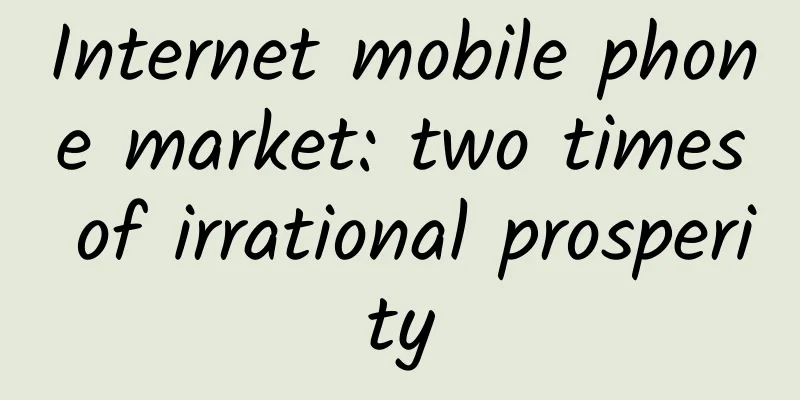Internet mobile phone market: two times of irrational prosperity

|
Recently, an article talked about Xiaomi's success as an irrational prosperity, which I don't agree with. The context of irrational prosperity is mostly used to describe the overall market rather than specific companies. The overall market has no decision-making body and is regulated by the "invisible hand", which makes it easy for irrational states to occur. Companies have clear decision-making bodies or decision-makers, and the decisions they make are often the best choices under the current or foreseeable circumstances. As far as companies are concerned, they are basically rational. Third parties may come to different conclusions from different perspectives. Therefore, it is not appropriate to use "irrational prosperity" to examine companies. In the Internet mobile phone market, there have indeed been two irrational prosperity states. The protagonists of the two irrational booms were not platform operators, and the development of platform operators was relatively stable. This is reflected in the steady growth of online mobile phone sales and revenue, with B2C always occupying a dominant position, accounting for more than 70% of the market share. Among them, although the market share of each platform player has changed, it is not drastic, and the sales concentration is relatively high. JD.com is the only one, accounting for half of the market share; Tmall has a quarter of the market share. The two irrational booms were mainly aimed at changes in mobile phone manufacturers. They had a certain impact on the sales of online mobile phones, but they were more reflected in the number of participants and their performance behaviors. The first was the "mobile phone boom" of Internet companies: from August 2011 to the end of 2012, Internet companies saw the opportunity of smart phone replacement and took the initiative to strive for it with idealism, trying to subvert traditional mobile phone manufacturers. However, only a few succeeded. In August 2011, Xiaomi officially started accepting pre-orders for its smartphones, sparking a wave of internet companies making smartphones. By October 2012, more than 100 internet companies, including traditional internet giants such as Baidu and 360, as well as Shanda and Xiaolajiao, had proposed plans to make smartphones. Internet companies have their own "rational considerations" for making mobile phones: 2011 to 2012 was the period of upgrading from feature phones to smart phones, which provided unprecedented opportunities for the implementation of mobile Internet business. Most Internet companies have experience in cooperating with mobile phone manufacturers and channel agents for customization. In addition, Xiaomi's successful exploration and the desire of some Internet companies to tell stories to the capital market led to a situation of swarming in. The reason why it is irrational is that most Internet companies only see the possibility of "disrupting" traditional companies, and only focus on developing their own business, while ignoring user experience and underestimating the operating environment and complexity, including software and hardware integration, supply chain management, product quality control, channel expansion and after-sales service. As a result, the NetEase mobile phone team was disbanded in July 2012, 360 stopped cooperating with special-purpose machines in September, Guo Chaohui, CEO of Guokr Electronics, resigned in November, and many unknown companies withdrew. By the end of 2012, this irrational boom bubble had basically burst, and the market returned to rationality. After this boom, only a few were left, and they continued to explore their own paths. The second time was the "Internet wave" of traditional mobile phone manufacturers: from the second half of 2013 to now, traditional mobile phone companies have realized the impact brought by Internet companies and the weakness of traditional channels, and have passively made choices with realism. After blindly following, they are returning to rationality. Traditional mobile phone manufacturers have been doing e-commerce, but they only regard e-commerce as an optional channel. It is not a first-launch platform, but more often a place to deal with tail goods. After the "mobile phone boom" of Internet companies subsided, Xiaomi, a representative of success, continued to develop rapidly, especially after entering the top 5 in market share in Q4 2013, which touched the sensitive nerves of traditional mobile phone manufacturers. From the second half of 2013 to 2014, the Internet mobile phone market was extremely chaotic and lively. There were Xiaomi, Meizu, LeTV, Tudou, OnePlus, Bajia, Hammer, etc., which started online, and China Cool Union, which started offline and expanded into the online market. (1) Behind the prosperity, we see some irrational factors. 1. Traditional mobile phone manufacturers have realized the urgency of entering the e-commerce channel and need to make a quick decision. On the one hand, the scale of the operator channel is gradually shrinking, and the e-commerce channel is an important way to increase market share. On the other hand, through the e-commerce channel, the intermediate costs can be reduced, and products with higher cost performance can be provided, which is more competitive. E-commerce channels must be taken. 2. Knowing the urgency but not knowing how to proceed is the biggest problem. He Xiaojun, general manager of Gionee's e-commerce brand IUNI, once said, "For a long time, traditional mobile phone manufacturers have been skeptical about Xiaomi's success." Traditional mobile phone manufacturers have always been inadequate in their understanding of the "soft" aspects, including the interface UI, community management and fans, etc. But they all adopted a follow-up strategy. The first is to launch e-commerce brands. Huawei launched Honor, Coolpad launched Dasheng, ZTE has Red Bull, Lenovo has Golden Fighter, Gionee has IUNI, Tianyu has Nibiru, etc. Honor and Dasheng are leading the way and have been independent one after another. Second, in terms of publicity and price, they simply imitated Xiaomi and attacked Xiaomi. Typical examples are: Xiaomi launched the Redmi Note with the slogan "Always believe that good things are about to happen"; Huawei Honor added in, claiming "better things have already happened"; Lenovo Golden Fighter S8 was not to be outdone, saying "good things have just begun"; Beidou Qingcong said "better things will happen"; ZTE launched Red Bull, the most direct, "besides fighting each other, what else can you do?" The third is to increase cooperation with third-party e-commerce platforms. Five ZTE mobile phones have joined JDPhone plan, and signed a 3.5 billion yuan strategic cooperation agreement with JD. Huawei has also joined JDPhone, and Honor 3C is exclusively launched on JD.com. Coolpad and JD.com have reached a 10 billion yuan strategic cooperation agreement, and Coolpad Dasheng F1 Unicom version was launched on JD.com. Lenovo and JD.com have reached a 12 billion yuan strategic cooperation intention, and the e-commerce brand Golden Fighter S8 was exclusively launched on JD.com. In ZTE and Lenovo, there is also a manifestation of "not knowing how to go". There is no clear line between the ZTE brand and the Nubia brand, and both are going offline. Lenovo has an Internet product series and models, but no dedicated brand. Yang Yuanqing has disagreed with Internet sales for a long time. 3. Learned but didn’t learn the key points. The products of every mobile phone manufacturer are similar and come from similar supply chain manufacturers. The difference is the differentiation of brand positioning, which is mainly reflected in the ability to tell stories, or feelings. Hammer Mobile learned the Internet sales model, but didn’t learn the key points. It overestimated its control over the industrial chain and the power of feelings. (2) This irrational state did not last long, and there is now a trend of returning to rationality. 1. In terms of player changes, there are winners and losers, prophets and latecomers. Thinking and choosing in trial and error or observation is a manifestation of rationality. Huawei Honor and Coolpad Dashen have become successful. According to the market share of domestic B2C website mobile phone brands in Q3 this year released by iResearch, the top three domestic mobile phone brands are Huawei, Xiaomi and Coolpad, while Huawei is mainly Honor and Coolpad is mainly Dashen. Judging from the sales of B2C websites alone, the "big and small Rong" pattern of domestic mobile phone e-commerce has been formed. Gionee IUNI admitted failure, and the helmsman He Xiaojun quietly resigned. The average monthly sales of e-commerce brand product U2 is less than 10,000 units, and the total volume does not exceed 50,000 units. The price reduction of Hammer Mobile Phone T1 recognizes the difficulty of making mobile phones and the price of sentimentality, and also warns manufacturers who take the sentimental route. Lenovo has always hesitated in terms of Internet brands. Finally, in October this year, it made up its mind to establish a new subsidiary and launch Internet terminals based on the Internet model. 2. In terms of product layout, the main players have expanded their product lines through practice and carried out more refined planning, which is a manifestation of rationality. Carrying out refined product layout will inevitably involve more resource investment, and the premise is that the development direction has been found and the development path has been clarified. Honor launched two sub-brands, Honor and Play, with 1,500 yuan as the boundary. The upper part is Honor, which competes with the Xiaomi brand, and the lower part is Play, which competes with the Redmi brand. And Honor has set a sales target of 40 million units in 2015. Dashen has established three main product series, X, N, and F. The price of the F series is about 1,000 yuan, the price of the X series is about 1,500 yuan, and the price of the N series is about 2,000 yuan. 3. In terms of channel model, it is rational to recognize the boundaries of online channels and develop an O2O model. The growth rate of online sales space depends on the speed of network infrastructure construction and the formation of online shopping habits. This process is slow and cannot support the rapid growth of many players, so O2O becomes an inevitable choice. At present, two typical models have been formed: one model is represented by Xiaomi, which integrates distribution and retail, controls the rhythm through online hype, and increases the scale through offline price increases. For example, for a product priced at 1999 yuan, 30% is sold online and 70% is sold online. The online price is 1999 yuan, and the offline price may be increased by about 300 yuan. This is mainly due to the power of distributors, that is, online retail and distribution are done at the same time. Huawei Honor, Coolpad Dashen, and even small manufacturers such as Xiao Lajiao all play this way. The other model is represented by Meizu, which has the same price online and offline, and pays more attention to the product experience offline. ZTE, Lenovo, Huawei, etc. all have some products adopting this model. 4. In terms of fan management culture, they have formed their own unique understanding, which is a manifestation of rationality. E-commerce brands must have the ability to tell stories, especially to gain recognition from fans. Xiaomi emphasizes fan enthusiasm. Huawei Honor's fan management philosophy is rational communitarianism, highlighting the rational and resonant value recognition of young people of "brave to be yourself", adhering to the pursuit of ultimate products, and not compromising on performance and quality. Zhu Fanghao, president of Coolpad Dashen, once talked about the misunderstanding of Xiaomi's "fan economy" on Weibo, and also expressed his thoughts on fan management culture. As a winner of Toutiao's Qingyun Plan and Baijiahao's Bai+ Plan, the 2019 Baidu Digital Author of the Year, the Baijiahao's Most Popular Author in the Technology Field, the 2019 Sogou Technology and Culture Author, and the 2021 Baijiahao Quarterly Influential Creator, he has won many awards, including the 2013 Sohu Best Industry Media Person, the 2015 China New Media Entrepreneurship Competition Beijing Third Place, the 2015 Guangmang Experience Award, the 2015 China New Media Entrepreneurship Competition Finals Third Place, and the 2018 Baidu Dynamic Annual Powerful Celebrity. |
<<: Can Nokia be reborn in the mobile phone industry?
>>: Has Taobao's "QuA" revolutionized online travel?
Recommend
An inventory of 3 common ways to play in social networks!
There are many different ways to play in a commun...
20 tips for hot-selling headlines!
Besides the content, the most important thing abo...
Pinduoduo Product Analysis Report
Pinduoduo has developed rapidly since it appeared...
Subsidies for new energy vehicles are withdrawn, and the income from point trading is only 1/10 of the subsidies
How can enterprises bear the high costs after the...
[World Spine Day] Lower back pain, waist relief exercises can help
October 16th of every year is World Spine Day bec...
How far can Uber go in China?
No one can accurately predict the final outcome o...
Loongson: A pure Chinese chip with a new lease of life
Speaking of chips, they have always been the focu...
Who will win the battle of smart TVs?
Since the emergence of Internet TV in 2006, smart...
Winter mood "collapse"? Don't panic, these tips will help you see the sun again!
Every winter, many people often feel as if their ...
iPhone 7 copied Note7, causing tragedy, but Apple fans said not to jump to conclusions
According to technology media 9to5mac, a video of ...
Protecting Audio Privacy During Cell Phone Calls with Sound Masking
background Malware violates the privacy of mobile...
What are some side jobs suitable for office workers? What other side jobs can you do while working?
With the continuous development of technology, pe...
Technology News丨Omicron strain becomes a "serious threat" to the UK; Japanese wholesalers sell Chinese eels as Japanese-made
【Today’s cover】 On December 18, the winter scener...
I thought I was gaining weight, but it turned out to be a tumor?
Review expert: Zhang Jianwei, deputy chief physic...
A brief discussion on APP promotion and operation: How to place advertisements accurately?
Preface As of the end of March this year, accordi...









